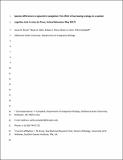Files in this item
Species differences in egocentric navigation : the effect of burrowing ecology on a spatial cognitive trait in mice
Item metadata
| dc.contributor.author | Bruck, Jason N. | |
| dc.contributor.author | Allen, Noah A. | |
| dc.contributor.author | Brass, Kelsey E. | |
| dc.contributor.author | Horn, Brian A. | |
| dc.contributor.author | Campbell, Polly | |
| dc.date.accessioned | 2018-03-28T23:33:45Z | |
| dc.date.available | 2018-03-28T23:33:45Z | |
| dc.date.issued | 2017-05 | |
| dc.identifier | 249488896 | |
| dc.identifier | 5cdefa08-fb74-40ac-a28b-bc60089bda50 | |
| dc.identifier | 85016277964 | |
| dc.identifier.citation | Bruck , J N , Allen , N A , Brass , K E , Horn , B A & Campbell , P 2017 , ' Species differences in egocentric navigation : the effect of burrowing ecology on a spatial cognitive trait in mice ' , Animal Behaviour , vol. 127 , pp. 67-73 . https://doi.org/10.1016/j.anbehav.2017.02.023 | en |
| dc.identifier.issn | 0003-3472 | |
| dc.identifier.uri | https://hdl.handle.net/10023/13044 | |
| dc.description | This study was funded by start-up funds from Oklahoma State University to P.C. | en |
| dc.description.abstract | Efficient navigation is a critical component of fitness for most animals. While most species use a combination of allocentric (external) and egocentric (internal) cues to navigate through their environment, subterranean environments present a unique challenge in that visually mediated allocentric cues are unavailable. The relationship between egocentric spatial cognition and species differences in ecology is surprisingly understudied. We used a maze-learning task to test for differences in egocentric navigation between two closely related species of mice, the eastern house mouse, Mus musculus musculus, and the mound-building mouse, Mus spicilegus. The two species are sympatric in Eastern Europe and overlap in summer habitat use but differ dramatically in winter space use: whereas house mice occupy anthropogenic structures, mound-building mice survive the winter underground in intricate burrow systems. Given species differences in burrowing ecology, we predicted that M. spicilegus would learn the maze significantly faster than M. m. musculus when tested in complete darkness, a condition that eliminated allocentric spatial information and served as a proxy for the subterranean environment. We found strong support for this prediction. In contrast, the two species performed equally well when different mice were tested in the same maze with lights on. This context-specific species difference in spatial cognition suggests that enhanced egocentric navigation in M. spicilegus is an adaptation to the burrow systems on which the overwinter survival of young mound-building mice depends. The results of this study highlight the importance of ecological adaptations to the evolution of cognitive traits. | |
| dc.format.extent | 7 | |
| dc.format.extent | 395570 | |
| dc.language.iso | eng | |
| dc.relation.ispartof | Animal Behaviour | en |
| dc.subject | Learning | en |
| dc.subject | Memory | en |
| dc.subject | Mound building | en |
| dc.subject | Mus spicilegus | en |
| dc.subject | Route-based navigation | en |
| dc.subject | Spatial ecology | en |
| dc.subject | QH301 Biology | en |
| dc.subject | Ecology, Evolution, Behavior and Systematics | en |
| dc.subject | NDAS | en |
| dc.subject.lcc | QH301 | en |
| dc.title | Species differences in egocentric navigation : the effect of burrowing ecology on a spatial cognitive trait in mice | en |
| dc.type | Journal article | en |
| dc.contributor.institution | University of St Andrews. School of Biology | en |
| dc.contributor.institution | University of St Andrews. Sea Mammal Research Unit | en |
| dc.identifier.doi | 10.1016/j.anbehav.2017.02.023 | |
| dc.description.status | Peer reviewed | en |
| dc.date.embargoedUntil | 2018-03-28 |
This item appears in the following Collection(s)
Items in the St Andrews Research Repository are protected by copyright, with all rights reserved, unless otherwise indicated.

